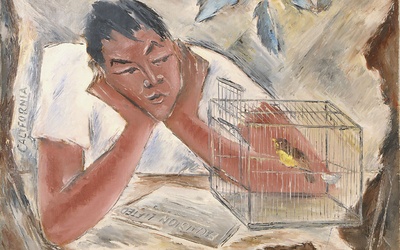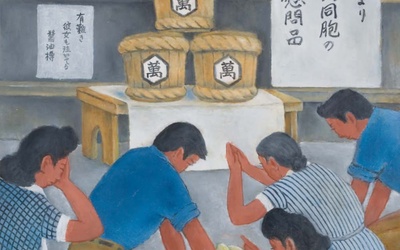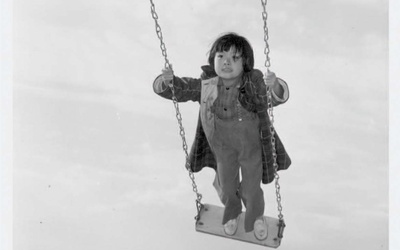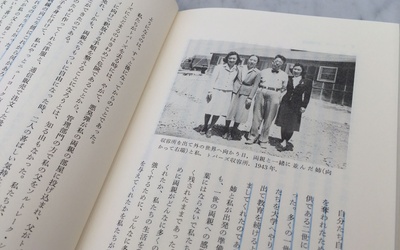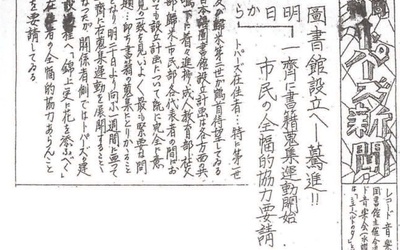Grandmother's Letter: Children and Books in Japanese American Internment Camps

Ms. Sachiko Aoki of the Children's Library Association in Tokyo told me about a letter written by a Japanese American that was published in a Japanese newspaper 10 or 20 years ago. The person spent time in an internment camp for Japanese Americans in the United States during World War II, and wrote that she "cannot forget the librarian who brought books to the camp." Encouraged by this letter, I began researching the lives of children in the internment camps and their relationship with books there.
*Reprinted from issues 133 to 137 of the quarterly magazine "Children and Books" (April 2013 to April 2014) published by the Children's Library Association.
Stories from this series
Chapter 4: Concentration Camps in the Wilderness: 1942-1946 — Part 2 (6)
June 29, 2015 • Yuri Brockett
Read Chapter 4 (5) >> 3. 1945 Cancelled Inter-Staff Matches — Early Spring In early spring, Manzanar experiences constant dust storms and light snow, but the boys' basketball team was full of excitement as they prepared for a friendly match against Bishop High School in a nearby town. It was the first time the team would be playing against an opposing school, so the team was very motivated. After getting permission from the Western Defense Command, the Bishop School Board …
Chapter 4: Concentration Camps in the Wilderness: 1942-1946 — Part 2 (5)
June 22, 2015 • Yuri Brockett
Read Chapter 4 (4) >> 2. 1944 Comfort goods arrive from Japan on an exchange ship — Early spring The scent of home arrived on a ship that exchanged prisoners between Japan and the United States. Supplies procured with funds raised in Japan to help Japanese nationals residing in enemy countries arrived via the Red Cross. 1 The first exchange ship brought green tea, while the second ship brought green tea, miso paste, soy sauce, medicine, entertainment items, and books. …
Chapter 4: Concentration Camps in the Wilderness: 1942-1946 — Part 2 (4)
June 15, 2015 • Yuri Brockett
Read Chapter 4 (3) >> Children's daily life—Summer By the time they reached high school age, there were many organized pastimes, such as baseball, basketball, and dance parties, but organized activities for preteens were limited, and they often hung around the camp in groups and caused trouble. So the administration introduced Boy Scout and Girl Scout activities, and gathered boys together to form a tackle football team. Here is a look at the daily life of children from a report …
Chapter 4: Concentration Camps in the Wilderness: 1942-1946 — Part 2 (3)
June 8, 2015 • Yuri Brockett
Read Chapter 4 (2) >> Time to leave Those who answered "yes, yes" to the 27th and 28th questions and were recognized as loyal were encouraged to leave the camps early to join the military or to work or study in Midwestern or Eastern towns. To help Nisei students who had been evicted midway through their studies return to college, the Quaker American Friends Service Committee backed the National Japanese American Student Relocation Council, which quickly got to work, helping …
Chapter 4: Concentration Camps in the Wilderness: 1942-1946 — Part 2
June 1, 2015 • Yuri Brockett
Read Chapter 4 (1) >> Loyalty Registration After The purpose of the loyalty registry was to separate those who were loyal to America from those who were not, to encourage those confirmed as loyal to America to serve in the military or to return quickly to American society through work or studies, and to isolate those deemed disloyal. However, the poorly designed questionnaire caused anxiety and confusion in the camps, so question 27, "Are you willing to serve in the …
Chapter 4: Concentration Camps in the Wilderness: 1942-1946 — Part 2 (1)
May 25, 2015 • Yuri Brockett
Read Chapter 3 (6) >> The other day, after the school lesson was over, I headed to a bakery I'd never been to before. I took a bus and walked using a map app. It took nearly an hour to get there. My dream is to have my own bakery. From next spring, I plan to begin my training at a local bakery. During this preparation period, These days, I visit many bakeries. I'm researching to see if I can …

